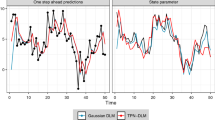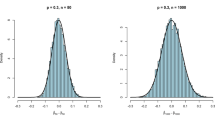Abstract
The popular Expectation Maximization technique suffers a major drawback when used to approximate a density function using a mixture of Gaussian components; that is the number of components has to be a priori specified. Also, Expectation Maximization by itself cannot estimate time-varying density functions. In this paper, a novel stochastic technique is introduced to overcome these two limitations. Kernel density estimation is used to obtain a discrete estimate of the true density of the given data. A Stochastic Learning Automaton is then used to select the number of mixture components that minimizes the distance between the density function estimated using the Expectation Maximization and discrete estimate of the density. The validity of the proposed approach is verified using synthetic and real univariate and bivariate observation data.
Similar content being viewed by others
References
Poznyak AS, Najim K, Gomez-Ramirez E (1994) Learning automata: theory and applications. Self-learning control of finite Marker chains. Pergamon, New York
Poznyak AS, Najim K (1997) Learning automata and stochastic optimization. Lecture Notes in Control and Information Sciences 225. Springer
Abd-Almageed W, Smith CE (2002) Mixture models for dynamix statistical pressure snakes. In: Proceedings of IEEE internation conference on pattern recognition, pp 721-724
Abu-Naser A, Galatsanos NP, Wernick MN, Schonfeld D (1998) Object recognition based on impulse restoration with use of the expectation-maximization algorithm. J Opti Soc Am A (Optics Image Science and Vision) 15(9):2327–2340
Bensmail H, Celeus G, Rafetry A, Robert C (1997) Inference in model-based cluster analysis. Stat Comput 7:1–10
Biernacki C, Celeux G, Govaert G (2000) Assessing a Mixture Model for Clustering with the Integrated Classification Likelihood. IEEE Trans Pattern Anal Mach Intell 22(7):719–725
Campbell J, Fraley C, Murtagh F, Raftery A (1997) Linear Flaw Detection in Woven Textiles Using Model-Based clustering. Pattern Recognit Lett 18:1539–1548
Dasgupta A, Rafetry A (1998) Detecting Features ni Spatial Point Patterns with Clutter Via Model-Based Clustering. J Am Stat Assoc 93:294–302
Dempster AP, Laird NM, Rubin DB (1977) Maximum Likelihood from Incomplete Data via the EM Algorithm. J R Stat Soc B-39:1–38
Elgammal A, Duraiswami R, Davis L (2003) Efficient kernel density estimation using the fast gauss transform with applications to color modeling and tracking. IEEE Trans Pattern Anal Mach Intell 25(11):1499–1504
Figueirdeo M, Jain A (2002) Unsupervised learning of finite mixture models. IEEE Trans Pattern Anal Mach Intell 24(3):381–396
Greengard L, Strain J (1991) The Fast Gauss Transform. SIAM J Sci Comput 12(1):79–94
Johnson D, Sinanovic S (2001) Symmetrizing the Kullback-Leibler Distance. IEEE Trans Inf Theory (Submitted)
Fu KS, McMurtry GJ (1966) A study of stochastic automata as a model for learning and adaptive controllers. IEEE Trans Autom Control 11:379–387
Narendra KS, Thathachar MAL (1974) Learning automata: a survey. IEEE Trans Syst Man Cybern 14:323–334
Kullback S (1968) Information theory and statistics. Dover, New York
Thathachar MAL, Sastry PS (2002) Varieties of learning automata: an overview. IEEE Trans Syst Man Cybern 32(6):711–722
Neal R (1992) Bayesian mixture modeling. In: Proceedings of 11th International workshop on maximum entropy and bayesian methods of statistical analysis, pp 197–211
Nefian AV, Liang L, Pi X, Xiaoxiang L, Mao C, Murphy K (2002) A coupled HMM for audio-visual speech recognition. In: International conference on acoustics speech and signal processing (CASSP’02) Orlando FL, pp 13–17
Parzen E (1962) On the Estimation of a Probability Density Function and the Mode. Ann Math Stat 33:1065–1076
Richardson S, Green P (1997) On Bayesian analysis of mixturtes with unknown number of componenets. J R Stat Soc 59:731–792
Tsetlin ML (1962) On The Bahavior of Finit Automata in Random Media. Autom Remote Control 22:1210-1219
Yang C, Duraiswami R, Gumerov N, Davis L (2003) Improved fast gauss transform and efficient kernel density estimation. In: Proc IEEE international conference computer vision
Author information
Authors and Affiliations
Corresponding author
Rights and permissions
About this article
Cite this article
Abd-Almageed, W., El-Osery, A.I. & Smith, C.E. Estimating time-varying densities using a stochastic learning automaton. Soft Comput 10, 1007–1020 (2006). https://doi.org/10.1007/s00500-005-0028-4
Published:
Issue Date:
DOI: https://doi.org/10.1007/s00500-005-0028-4




